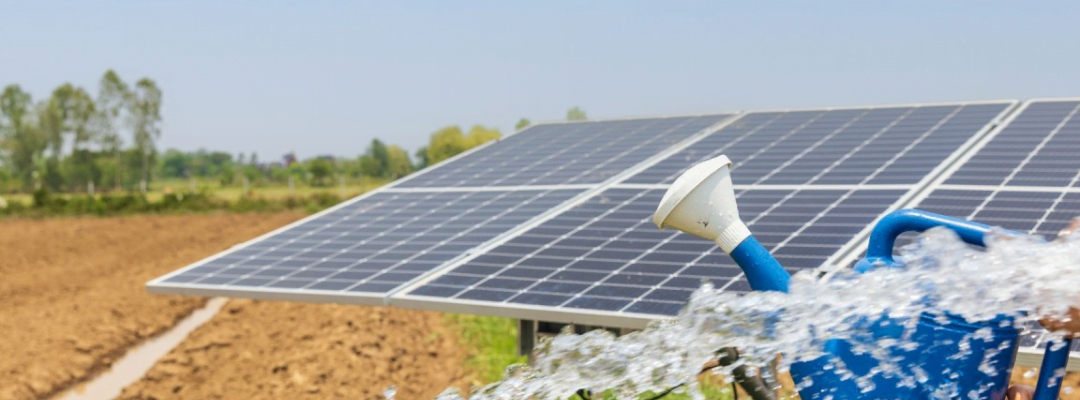When planning an agriculture off grid solar power system for irrigation, there are several critical factors to consider to ensure the system is efficient, reliable, and suitable for your farming needs. Here’s what you need to know:
1. Assess Irrigation Power Needs
- Water Requirements: Determine the volume of water required for irrigation based on the size of your land, type of crops, and climate. This helps calculate how much energy is needed to pump water.
- Pump Size: Depending on the depth of the water source (well or surface water), you’ll need a pump that matches the pressure and flow rate requirements of your irrigation system.
- Hours of Operation: Estimate how many hours per day the pump needs to run to meet irrigation demands.
2. System Components
- Solar Panels: Select panels that can generate sufficient electricity to power the irrigation system. The number and type of panels will depend on your energy needs, available sunlight, and the size of the system.
- Solar Pump: Opt for a solar water pump that matches your irrigation requirements. These pumps can either be AC or DC, with DC pumps being more efficient for solar-powered systems.
- Batteries (Optional): If irrigation is needed during non-sunlight hours or if you want backup power, install batteries to store excess energy generated during the day.
- Controller: A solar pump controller regulates the power from the panels to the pump, ensuring consistent water flow and protecting the pump from overvoltage or under-voltage.
- Inverter (Optional): If you use an AC-powered pump, you’ll need an inverter to convert DC power from the panels into AC. DC pumps, however, connect directly to the panels.
3. System Sizing
- Pump Power: Based on your water source depth, irrigation method (drip, sprinkler, etc.), and flow requirements, calculate the size of the pump in horsepower (HP) or kilowatts (kW).
- Solar Panel Array Size: Determine how many solar panels you need to power the pump. This is based on the pump’s energy requirements (in watts) and the sunlight available at your location.
- Battery Bank: If you decide to include batteries, ensure they are sized to store enough energy to run the pump during cloudy days or when irrigation is required at night.
4. Types of Irrigation Systems
- Drip Irrigation: Requires less water and energy, making it a good fit for solar-powered systems in remote areas with limited water resources.
- Sprinkler Systems: Requires more power due to higher water pressure needs. Ensure your solar pump system is adequately sized for the additional energy demand.
- Flood Irrigation: More energy-intensive and may require larger pumps and solar systems.
5. Location and Sunlight Availability
- Sunlight Hours: The performance of your solar panels will depend on the available sunlight, which varies by region and season. Design your system based on the average daily sunlight hours.
- Panel Orientation and Tilt: Solar panels should be oriented and tilted to capture maximum sunlight throughout the day. For agricultural purposes, install them in a location free of shading (trees, buildings, etc.).
- Seasonal Changes: Consider how sunlight hours change seasonally and plan for possible lower energy output during certain times of the year. A battery system can help store energy for these periods.
6. Cost Considerations
- Initial Investment: Solar irrigation systems have a higher upfront cost compared to diesel or grid-powered systems. However, they have significantly lower long-term operating costs.
- Long-Term Savings: After the initial installation, solar-powered systems have minimal operational costs, as sunlight is free. This helps reduce fuel or electricity costs, making solar irrigation more cost-effective over time.
- Maintenance: Solar systems have low maintenance needs, especially compared to diesel-powered pumps, which require regular servicing and fuel supply management.
7. Environmental and Sustainability Benefits
- Renewable Energy: Solar power is a clean, renewable energy source, making it an environmentally friendly option for agriculture.
- Reduced Carbon Footprint: By using solar-powered irrigation, you reduce reliance on fossil fuels, lowering greenhouse gas emissions and contributing to sustainable farming practices.
- Water Conservation: Pairing solar energy with efficient irrigation systems like drip irrigation can significantly conserve water, especially in arid or drought-prone regions.
8. System Reliability and Backup
- Dependable Power Source: Solar systems provide reliable power in off-grid areas where access to the electrical grid is unavailable or inconsistent.
- Backup Power (Optional): For areas with variable weather or prolonged cloudy periods, a backup generator or additional battery storage may be needed to ensure continuous water supply.
9. Regulatory and Incentive Opportunities
- Government Subsidies: Many governments provide subsidies or incentives for solar-powered agricultural systems. Research available programs that can help reduce the initial cost of installation.
- Permits and Approvals: Check with local authorities regarding any permits or approvals needed to install an off-grid solar system for irrigation.
10. Maintenance and Durability
- Panel Cleaning: Solar panels in agricultural areas can accumulate dust or dirt, which can reduce their efficiency. Regular cleaning and maintenance are important for optimal performance.
- Pump Maintenance: Solar pumps generally require minimal maintenance but should be checked periodically to ensure smooth operation, especially in harsh or remote environments.
- System Lifespan: High-quality solar panels and pumps can last 20 years or more, providing long-term reliability and cost savings.
11. Scalability
- Future Expansion: If your irrigation needs increase or if you expand your farming operations, make sure your solar system can be easily scaled by adding more panels or pumps.
- Modular Systems: Some solar irrigation systems are modular, allowing for easy upgrades as water or energy needs grow.
12. Integration with Water Storage
- Water Tanks or Reservoirs: For maximum efficiency, consider integrating water storage solutions (e.g., tanks or ponds) that store excess water when solar energy is abundant, allowing you to irrigate even when solar production is low.
- Gravity-Fed Systems: Combining solar with gravity-fed irrigation from elevated storage tanks can reduce the energy needed for pumping, providing an efficient way to distribute water across fields.
By considering these factors, you can design an efficient, sustainable off-grid solar-powered irrigation system that meets the specific needs of your agricultural operations.

